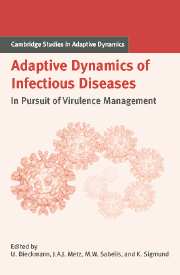Book contents
- Frontmatter
- Contents
- Contributing Authors
- List of Boxes
- Notational Standards
- 1 Introduction
- A Setting the Stage
- B Host Population Structure
- Introduction to Part B
- 6 Variation in Susceptibility: Lessons from an Insect Virus
- 7 Contact Networks and the Evolution of Virulence
- 8 Virulence on the Edge: A Source–Sink Perspective
- C Within-Host Interactions
- D Pathogen–Host Coevolution
- E Multilevel Selection
- F Vaccines and Drugs
- G Perspectives for Virulence Management
- References
- Index
- International Institute for Applied Systems Analysis
7 - Contact Networks and the Evolution of Virulence
Published online by Cambridge University Press: 15 January 2010
- Frontmatter
- Contents
- Contributing Authors
- List of Boxes
- Notational Standards
- 1 Introduction
- A Setting the Stage
- B Host Population Structure
- Introduction to Part B
- 6 Variation in Susceptibility: Lessons from an Insect Virus
- 7 Contact Networks and the Evolution of Virulence
- 8 Virulence on the Edge: A Source–Sink Perspective
- C Within-Host Interactions
- D Pathogen–Host Coevolution
- E Multilevel Selection
- F Vaccines and Drugs
- G Perspectives for Virulence Management
- References
- Index
- International Institute for Applied Systems Analysis
Summary
Introduction
Virulence management can be defined as that set of policies that not only aims to minimize the short-term impact of parasites on their host population (e.g., incidence, mortality, and morbidity), but also to account for the longer-term consequences of the evolutionary responses of these parasites, for example by adopting measures that select for less virulent strains.
An important question pertaining to the scope of virulence management concerns the effect of contact structures in the host population. For successful transmission many parasites require close contact between the host they are infecting and new susceptible hosts. Consequently, the network of social contact in their host population is of paramount importance. It has already become clear that differently structured networks lead to different types of epidemiology (Keeling 1999). For example, a sparsely connected host population is more difficult to invade than a densely connected host population. But to what extent will the contact structure of their host population affect the evolution of the parasites, in particular of their virulence? Can we change the selective pressures on the parasites by modifying these contact structures? Claessen and de Roos (1995) and Rand et al. (1995) carried out computer simulations of evolving parasites in spatially structured host populations and concluded that less virulent (hypovirulent) parasites are favored with respect to well-mixed systems. Clearly, parasite evolution does depend on host population structure. Qualitative insight into the pertinent aspects of population structure, in the form of social networks, is still lacking, however (Wallinga et al. 1999).
- Type
- Chapter
- Information
- Adaptive Dynamics of Infectious DiseasesIn Pursuit of Virulence Management, pp. 85 - 103Publisher: Cambridge University PressPrint publication year: 2002
- 27
- Cited by



